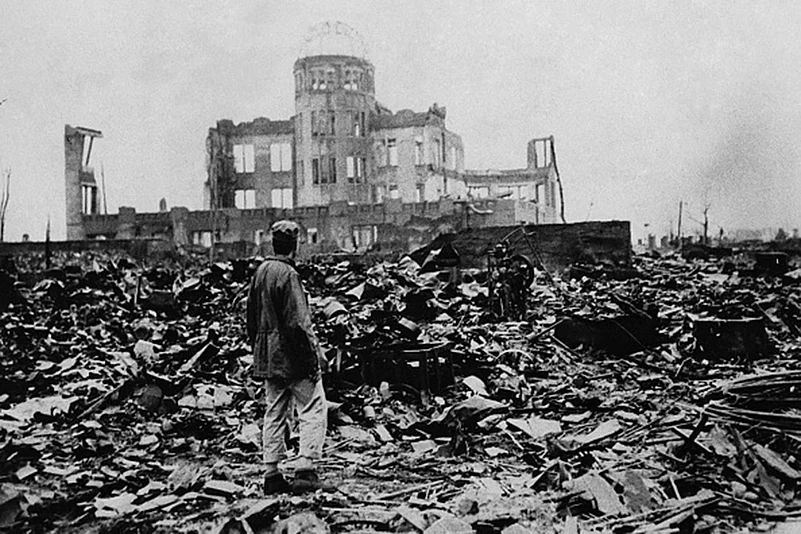“Chernobyl is like the war of all wars. There’s nowhere to hide. Not underground, not underwater, not in the air.”
—Svetlana Alexievich, Voices from Chernobyl: The Oral History of a Nuclear Disaster
“The sparrows disappeared from our town in the first year after the accident. They were lying around everywhere—in the yards, on the asphalt. They’d be raked up and taken away in the containers with the leaves. They didn’t let people burn the leaves that year, because they were radioactive, so they buried the leaves. The sparrows came back two years later.
—Excerpt from Voices from Chernobyl: The Oral History of a Nuclear Disaster by Svetlana Alexievich, who received the 2015 Nobel Prize in Literature “for her polyphonic writings, a monument to suffering and courage in our time”.
In such times, you remember the stories. They say flowers became radioactive then. A newlywed Lyudmilla Ignatenko, the wife of fireman Vasily Ignatenko, was told her husband is a nuclear reactor in the opening story of this book.
“He’s dying.” And she says to me: “What did you expect? He got 1,600 roentgen. Four hundred is a lethal dose. You’re sitting next to a nuclear reactor.”
On April 26, 1986, the No. 4 reactor at the Chernobyl power station blew apart and thousands of men who were ill-equipped were sent to contain the situation.
We seem to be on the brink of another war. And this war, if it escalates, will be far more lethal than we can imagine. Perhaps this is why we must return to stories to understand the horrors of a nuclear explosion. People have been killed on both sides. The “imposed war” will lead to a crisis, that might lead to a larger war.
In a newsroom, you must grapple with all possibilities and impossibilities. The impossibility today is the mere acknowledgement that wars kill people like me and you. The possibility that looms over is a nuclear war or at least an explosion. Remember the Fat Man that was dropped on Nagasaki and killed, within a minute, at least 30,000 people. Chernobyl is another such story. A story of wreckage, but we are unhindered in our zeal to wage wars that we build up to be the solution for existential threats that we assign and attribute to ourselves and market to the people. Truth is the first and foremost casualty in such cases.
For months, we’ve watched bombs fall, homes burn, children die in Gaza, while leaders call for more war. Now, we are seeing another war between Israel and Iran and hoping that it doesn’t escalate, because we know from history that there will be no place to hide for many.
What does it mean for a newsroom then? The last few days have been sad, hectic and sometimes, I wonder if we are becoming numb to everything. Over 270 died in Air India’s June 12 crash. Investigations continue, but for grieving families, closure may never come, presenting a painful reality.
A newsroom writes history’s first draft—not propaganda, but stories of suffering. As we mourned the crash victims, news broke: Israel attacked Iran, and Western media rushed to justify it.
We have seen the reportage and the language used to make people believe in the justification for a war. The 2003 Iraq War, hyped by media over WMDs, was called “illegal” by UN chief Kofi Annan in 2004. Which war is legal? In the US, pro-Palestinian voices face arrests and deportation, with solidarity often mislabelled as anti-Semitism and protest deemed unlawful. In such times, the radical act of being unapologetically present is the only dutiful one, the only correct course of action.
The media is either a target, like Iran’s IRIB hit by Israel, or an auxiliary, like Indian anchors spreading fake news during ‘Operation Sindoor’ after the brutal Pahalgam terror attack.
There is pressure on the media which doesn’t buy into the propaganda. This is also an information war and it is difficult for us to get to any truth in a post-truth world where images can be manipulated easily with new technologies and conflicts are for the control of resources, for greed and for power.
In postmodern conflicts, information is power. There are new standards for the coverage and representation of war and these are imposed most of the time and often undermine the credibility of the media because we are all complicit in this strange interlocking of political and military power, war industries and corporate media.
That’s why the propaganda discourse is now paraded as the one and only truth and journalists who want to search for the truth are often targeted and persecuted.
Language is an ideological tool. Some journalists echo official lines; others focus on human suffering—war’s real story. Objectivity is demanded, yet how can one be neutral about death? Reporting must move beyond duty to conscience. What we write and see shapes public opinion, which alone can resist war’s normalisation and delegitimise its violence.
I am rereading the book about Chernobyl and hoping that flowers don’t become radioactive ever again. That’s my journalism. No war is heroic.
This issue of 카지노 is for those who lost their loved ones in the plane crash. We changed the cover thrice while putting this issue together because any war is a reflection of us as people and people dying anywhere are our people. This is to say we are here.




















